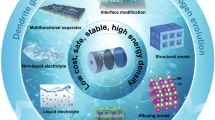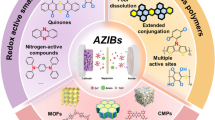Abstract
Metallic Zn can be used as an anode for aqueous zinc-ion batteries due to its low redox potential, rich resources, and high theoretical capacity. However, its practical application is limited by dendrite growth and side reactions. Herein, a simple in-situ growth strategy was applied to fabricate a Zn anode with a ZnO protective layer (Zn/ZnO) to lengthen the cycle life and inhibit the dendrite growth and side reactions. At 1 mA h cm−2 capacity, Zn/ZnO exhibits long-time stability (2500 h) at 1 mA cm−2 and outstanding rate capability (1000 h at 10 mA cm−2) in symmetrical cells. Furthermore, the average coulombic efficiency of the Zn/ZnO//Ti cell is 99.4%, which is desirable at 5 mA cm−2. In addition, the Zn/ZnO//MnO2 cell can maintain a specific capacity of 167.2 mA h g−1 after 800 stable cycles. This work presents a simple fabrication method for Zn anode with excellent performance and suggests the huge possibilities of implementing practically rechargeable aqueous zinc-ion batteries.
Similar content being viewed by others
References
Feng X, Wu H H, Gao B, et al. Lithiophilic N-doped carbon bowls induced Li deposition in layered graphene film for advanced lithium metal batteries. Nano Res, 2022, 15: 352–360
Huang Y, Tang Y, Yuan W, et al. Challenges and recent progress in thermal management with heat pipes for lithium-ion power batteries in electric vehicles. Sci China Tech Sci, 2021, 64: 919–956
Xie C, Li Y, Wang Q, et al. Issues and solutions toward zinc anode in aqueous zinc-ion batteries: A mini review. Carbon Energy, 2020, 2: 540–560
Ke C Z, Liu F, Zheng Z M, et al. Boosting lithium storage performance of Si nanoparticles via thin carbon and nitrogen/phosphorus co-doped two-dimensional carbon sheet dual encapsulation. Rare Met, 2021, 40: 1347–1356
Cai M, Zhang H, Zhang Y, et al. Boosting the potassium-ion storage performance enabled by engineering of hierarchical MoSSe nanosheets modified with carbon on porous carbon sphere. Sci Bull, 2022, 67: 933–945
Yi Z, Chen G, Hou F, et al. Strategies for the stabilization of Zn metal anodes for Zn-ion batteries. Adv Energy Mater, 2020, 11: 2003065
Kang K, Meng Y S, Breger J, et al. Electrodes with high power and high capacity for rechargeable lithium batteries. Science, 2006, 311: 977–980
Cabana J, Monconduit L, Larcher D, et al. Beyond intercalation-based Li-ion batteries: The state of the art and challenges of electrode materials reacting through conversion reactions. Adv Mater, 2010, 22: E170–E192
Blanc L E, Kundu D, Nazar L F. Scientific challenges for the implementation of Zn-ion batteries. Joule, 2020, 4: 771–799
Liu Z, Qin L, Lu B, et al. Issues and opportunities facing aqueous Mn2+/MnO2-based batteries. ChemSusChem, 2022, 15
Li Z, Chen D, An Y, et al. Flexible and anti-freezing quasi-solid-state zinc ion hybrid supercapacitors based on pencil shavings derived porous carbon. Energy Storage Mater, 2020, 28: 307–314
Liu Z, Yang Y, Liang S, et al. pH-buffer contained electrolyte for self-adjusted cathode-free Zn-MnO2 batteries with coexistence of dual mechanisms. Small Struct, 2021, 2: 2100119
Ruan P, Liang S, Lu B, et al. Design strategies for high-energy-density aqueous zinc batteries. Angew Chem Int Ed, 2022, 61: 202200598
Verma V, Kumar S, ManalastasJr. W, et al. Undesired reactions in aqueous rechargeable zinc ion batteries. ACS Energy Lett, 2021, 6: 1773–1785
Yang Q, Guo Y, Yan B, et al. Hydrogen-substituted graphdiyne ion tunnels directing concentration redistribution for commercial-grade dendrite-free zinc anodes. Adv Mater, 2020, 32: 2001755
Park S H, Byeon S Y, Park J H, et al. Insight into the critical role of surface hydrophilicity for dendrite-free zinc metal anodes. ACS Energy Lett, 2021, 6: 3078–3085
Han C, Li W, Liu H K, et al. Principals and strategies for constructing a highly reversible zinc metal anode in aqueous batteries. Nano Energy, 2020, 74: 104880
Chen M, Zhou W, Tian Q, et al. Artificial solid electrolyte interface layer based on sodium titanate hollow microspheres assembled by nanotubes to stabilize zinc metal electrodes. J Energy Chem, 2022, 71: 539–546
Han X, Leng H, Qi Y, et al. Hydrophilic silica spheres layer as ions shunt for enhanced Zn metal anode. Chem Eng J, 2022, 431: 133931
Qiu M, Wang D, Tawiah B, et al. Constructing PEDOT:PSS/Graphene sheet nanofluidic channels to achieve dendrite-free Zn anode. Compos Part B-Eng, 2021, 215: 108798
Liu M, Yang L, Liu H, et al. Artificial solid-electrolyte interface facilitating dendrite-free zinc metal anodes via nanowetting effect. ACS Appl Mater Interfaces, 2019, 11: 32046–32051
Chen P, Yuan X, Xia Y, et al. An artificial polyacrylonitrile coating layer confining zinc dendrite growth for highly reversible aqueous zinc-based batteries. Adv Sci, 2021, 8: 2100309
Zhang Y, Zhu M, Wu K, et al. An in-depth insight of a highly reversible and dendrite-free Zn metal anode in an hybrid electrolyte. J Mater Chem A, 2021, 9: 4253–4261
Pan H, Shao Y, Yan P, et al. Reversible aqueous zinc/manganese oxide energy storage from conversion reactions. Nat Energy, 2016, 1: 16039
Zhao Z, Zhao J, Hu Z, et al. Long-life and deeply rechargeable aqueous Zn anodes enabled by a multifunctional brightener-inspired interphase. Energy Environ Sci, 2019, 12: 1938–1949
Mainar A R, Iruin E, Colmenares L C, et al. An overview of progress in electrolytes for secondary zinc-air batteries and other storage systems based on zinc. J Energy Storage, 2018, 15: 304–328
Xie X, Liang S, Gao J, et al. Manipulating the ion-transfer kinetics and interface stability for high-performance zinc metal anodes. Energy Environ Sci, 2020, 13: 503–510
Guo W, Zhang Y, Tong X, et al. Multifunctional tin layer enabled long-life and stable anode for aqueous zinc-ion batteries. Mater Today Energy, 2021, 20: 100675
Yang Y, Liu C, Lv Z, et al. Synergistic manipulation of Zn2+ ion flux and desolvation effect enabled by anodic growth of a 3D ZnF2 matrix for long-lifespan and dendrite-free Zn metal anodes. Adv Mater, 2021, 33: 2007388
Amann P, Klötzer B, Degerman D, et al. The state of zinc in methanol synthesis over a Zn/ZnO/Cu(211) model catalyst. Science, 2022, 376: 603–608
Kattel S, Ramírez P J, Chen J G, et al. Active sites for CO2 hydrogenation to methanol on Cu/ZnO catalysts. Science, 2017, 355: 1296–1299
Lupan O, Chow L, Pauporté T, et al. Highly sensitive and selective hydrogen single-nanowire nanosensor. Sens Actuat B-Chem, 2012, 173: 772–780
Xiao Q, Wang T. Improving the ethanol gas-sensing properties of porous ZnO microspheres by Co doping. Mater Res Bull, 2013, 48: 2786–2791
Kim M Y, Naveen M H, Gurudatt N G, et al. Detection of nitric oxide from living cells using polymeric zinc organic framework-derived zinc oxide composite with conducting polymer. Small, 2017, 13: 1700502
Wang L, Kang Y, Wang Y, et al. CuO nanoparticle decorated ZnO nanorod sensor for low-temperature H2S detection. Mater Sci Eng-C, 2012, 32: 2079–2085
Yang Q, Liang G, Guo Y, et al. Do zinc dendrites exist in neutral zinc batteries: A developed electrohealing strategy to in situ rescue in-service batteries. Adv Mater, 2019, 31: 1903778
Shi Y, Chen Y, Shi L, et al. An overview and future perspectives of rechargeable zinc batteries. Small, 2020, 16: 2000730
Zhang Q, Luan J, Tang Y, et al. Interfacial design of dendrite-free zinc anodes for aqueous zinc-ion batteries. Angew Chem Int Ed, 2020, 59: 13180–13191
Zeng Y, Zhang X, Qin R, et al. Dendrite-free zinc deposition induced by multifunctional CNT frameworks for stable flexible Zn-ion batteries. Adv Mater, 2019, 31: 1903675
Wang F, Hu E, Sun W, et al. A rechargeable aqueous Zn2+-battery with high power density and a long cycle-life. Energy Environ Sci, 2018, 11: 3168–3175
Zhang N, Huang S, Yuan Z, et al. Direct self-assembly of mxene on Zn anodes for dendrite-free aqueous zinc-ion batteries. Angew Chem Int Ed, 2021, 60: 2861–2865
Gao X, Wu H, Li W, et al. H+-insertion boosted α-MnO2 for an aqueous Zn-ion battery. Small, 2020, 16: 1905842
Author information
Authors and Affiliations
Corresponding authors
Additional information
This work was supported by the National Natural Science Foundation of China (Grant Nos. 22179071 and 52072217).
Supporting Information
The supporting information is available online at https://tech.scichina.com and https://link.springer.com. The supporting materials are published as submitted, without typesetting or editing. The responsibility for scientific accuracy and content remains entirely with the authors.
Supporting Information
Rights and permissions
About this article
Cite this article
Hou, Z., Tao, H., Wang, J. et al. Dendrite-free and stable Zn metal anodes with ZnO protective layer. Sci. China Technol. Sci. 65, 2361–2368 (2022). https://doi.org/10.1007/s11431-022-2117-9
Received:
Accepted:
Published:
Issue Date:
DOI: https://doi.org/10.1007/s11431-022-2117-9




